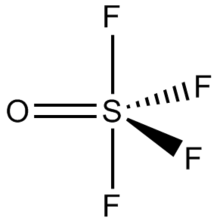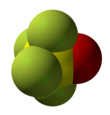Thionyl tetrafluoride

| |||
| |||
| Names | |||
|---|---|---|---|
| IUPAC name
Thionyl tetrafluoride
| |||
| Identifiers | |||
3D model (JSmol)
|
|||
| ChemSpider | |||
PubChem CID
|
|||
CompTox Dashboard (EPA)
|
|||
| |||
| |||
| Properties | |||
| SOF4 | |||
| Appearance | colorless gas | ||
| Density | 1.653−0.0036T (°C) liquid[1] | ||
| Melting point | −99.6 °C (−147.3 °F; 173.6 K) | ||
| Boiling point | −49 °C (−56 °F; 224 K) 5090 cal/mol heat of vapourisation[1] | ||
| reaction in water | |||
| log P | 7.2349−859.58/T−26275/T²[1] | ||
| Structure | |||
| distorted trigonal bipyramid | |||
| Hazards | |||
| GHS labelling: | |||
 
| |||
| Danger | |||
| H300, H310, H314, H330 | |||
| P260, P262, P264, P270, P271, P280, P284, P301+P310, P301+P330+P331, P302+P350, P303+P361+P353, P304+P340, P305+P351+P338, P310, P320, P321, P322, P330, P361, P363, P403+P233, P405, P501 | |||
| Related compounds | |||
Related oxohalides
|
Thionyl fluoride Selenyl tetrafluoride | ||
Related compounds
|
Phosphoryl trifluoride pentafluorosulfur hypofluorite sulfuryl fluoride | ||
Except where otherwise noted, data are given for materials in their standard state (at 25 °C [77 °F], 100 kPa).
| |||
Thionyl tetrafluoride, also known as sulfur tetrafluoride oxide, is an inorganic compound with the formula SOF4. It is a colorless gas.
The shape of the molecule is a distorted trigonal bipyramid, with the oxygen found on the equator. The atoms on the equator have shorter bond lengths than the fluorine atoms on the axis. The sulfur oxygen bond is 1.409Å. A S−F bond on the axis has length 1.596Å and the S−F bond on the equator has length 1.539Å. The angle between the equatorial fluorine atoms is 112.8°. The angle between axial fluorine and oxygen is 97.7°. The angle between oxygen and equatorial fluorine is 123.6° and between axial and equatorial fluorine is 85.7°.[2] The fluorine atoms only produce one NMR line, probably because they exchange positions.[1] It is isoelectronic with phosphorus pentafluoride.
Formation
[edit]Thionyl fluoride reacting with fluorine gas can produce thionyl tetrafluoride.[1] This was how the gas was first discovered by Moissan and Lebeau in 1902. They identified the formula by the pressure changes resulting from the reaction. Silver fluoride and platinum are capable of catalyzing the reaction.
It can also be formed the reaction of silver difluoride with thionyl fluoride at 392 °F (200 °C),[3] or by electrolyzing hydrogen fluoride with a solution of sulfur dioxide, which also made oxygen difluoride and sulfuryl fluoride. Thionyl chloride or thionyl fluoride electrolyzed with hydrogen fluoride produced even more of the gas.[4]
Reactions
[edit]Thionyl tetrafluoride reacts with water to make hydrofluoric acid, sulfurofluoridic acid, and sulfuryl difluoride. Mercury can strip off fluoride to make thionyl fluoride and mercurous fluoride. Strong bases result in formation of fluoride and fluorosulfate ions.[1]
Reactions with the strong Lewis acids, such as AsF5 and SbF5, result in the formation SOF3+ cation and the corresponding salts SOF3[AsF6] and SOF3[SbF6], respectively.[5]
Click chemistry
[edit]Thionyl tetrafluoride can be used in click chemistry through reactions with primary amines known as sulfur(VI) fluoride exchange (SuFEx).[6] This kind of reaction was the first "click" reaction to generate a three-dimensional core.
References
[edit]- ^ a b c d e f Harry Julius Emeléus and A.G. Sharpe Advances in Inorganic Chemistry Volume 2 Academic Press 1960 page 117 [1]
- ^ Hedberg, Lise; Hedberg, Kenneth (March 1982). "Thionyl tetrafluoride. Reanalysis of the molecular structure and resolution of the multiple model problem". The Journal of Physical Chemistry. 86 (5): 598–602. doi:10.1021/j100394a004.
- ^ Dudley, F. B. (1956). "Pentafluorosulfur Hypofluorite and Thionyl Tetrafluoride". Journal of the American Chemical Society. 78 (8): 1553–1557. doi:10.1021/ja01589a013.
- ^ Nagase, Shunji; Abe, Takashi; Baba, Hajime (1 July 1969). "Fluorination of Inorganic Sulfur Compounds". Bulletin of the Chemical Society of Japan. 42 (7): 2062–2064. doi:10.1246/bcsj.42.2062.
- ^ Brownstein, M.; Dean, P. A. W.; Gillespie, R. J. (1970-01-01). "The trifluorosulphur(VI) oxide cation, SOF3+". Journal of the Chemical Society D: Chemical Communications (1): 9–9. doi:10.1039/C29700000009. ISSN 0577-6171.
- ^ Li, Suhua; Wu, Peng; Moses, John E.; Sharpless, K. Barry (2017-02-01). "Multidimensional SuFEx Click Chemistry: Sequential Sulfur(VI) Fluoride Exchange Connections of Diverse Modules Launched From An SOF4 Hub". Angewandte Chemie International Edition. 56 (11): 2903–2908. doi:10.1002/anie.201611048. ISSN 1521-3773. PMC 5434761. PMID 28165188.


